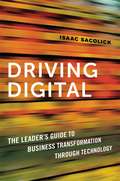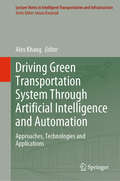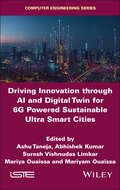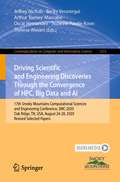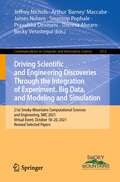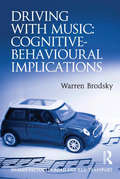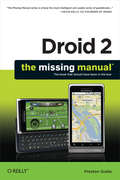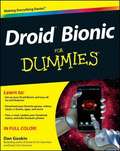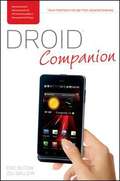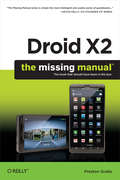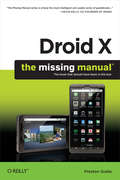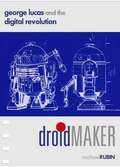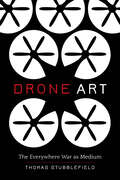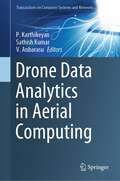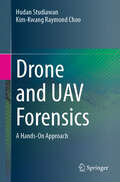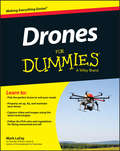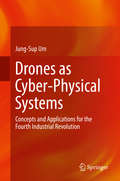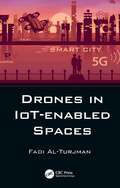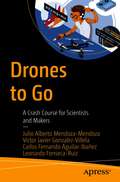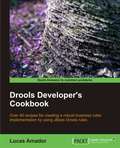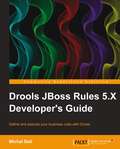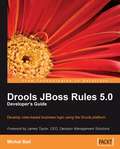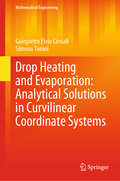- Table View
- List View
Driving Digital: The Leader's Guide to Business Transformation Through Technology
by Isaac SacolickEvery organization makes plans for updating products, technologies, and business processes. But that&’s not enough anymore for the twenty-first-century company. The race is now on for everyone to become a digital enterprise. For those individuals who have been charged with leading their company&’s technology-driven change, the pressure is intense while the correct path forward unclear. Help has arrived! In Driving Digital, author Isaac Sacolick shares the lessons he&’s learned over the years as he has successfully spearheaded multiple transformations and helped shape digital-business best practices. Readers no longer have to blindly trek through the mine field of their company&’s digital transformation. In this thoroughly researched one-stop manual, learn how to: • Formulate a digital strategy • Transform business and IT practices • Align development and operations • Drive culture change • Bolster digital talent • Capture and track ROI • Develop innovative digital practices • Pilot emerging technologies • And more! Your company cannot avoid the digital disruption heading its way. The choice is yours: Will this mean the beginning of the end for your business, or will your digital practices be what catapults you into next-level success?
Driving Green Transportation System Through Artificial Intelligence and Automation: Approaches, Technologies and Applications (Lecture Notes in Intelligent Transportation and Infrastructure)
by Alex KhangThis book is designed to help transportation professionals and construction experts to develop and implement successful smart systems, leveraging the current trends, equipment, and advanced technologies to drive the green transportation system development. Artificial intelligence (AI) is a new direction that has opened a revolution in technology and smart applications, and it is also the basis for creating a green environment in the net-zero era. Therefore, machines, devices, self-driving car, and robots controlled by artificial intelligence-based systems are now the model of a smart transportation ecosystem for which all these technologies are referred to as "green" industries. In past years, the idea of making a green environment has been existing and moving on the society 5.0 being as a country strategy, and today, AI technology continues its development on this prototype. Nowadays, AI has begun actions to resemble a person in a real sense, and the idea of human-liked robotics put forward by scientists has started to be realized and will probably complete its development as living machines in the near future. AI has many subsystems and application in various industries, some of which have automation more accurately and are more integrated in modern industries. This book also targets a mixed audience of specialists, analysts, engineers, scholars, researchers, academics, professionals, and students from different communities to share and contribute new ideas, methodologies, technologies, approaches, models, frameworks, theories, and practices to resolve the challenging issues associated with the leveraging of AI and Industrial Internet of Things (IIoT) in green transportation ecosystem.
Driving Innovation through AI and Digital Twin for 6G Powered Sustainable Ultra Smart Cities (ISTE Invoiced)
by Abhishek Kumar Mariya Ouaissa Mariyam Ouaissa Ashu Taneja Suresh Vishnudas LimkarThis book presents the 6G powered integration of Artificial Intelligence (AI) and Digital Twin (DT) technology for sustainable smart cities. In the context of smart cities, 6G, AI and DT hold enormous potential for transformation by boosting city infrastructure and planning, streamlining healthcare facilities, and improving transportation. 6G offers high speed and low latency seamless transfer of vast amounts of data which, when analysed with sophisticated AI models, enhance the decision-making capabilities for smart city infrastructure and urban planning. DT technology, through continuous monitoring and virtual modeling of urban ecosystems, enables predictive maintenance for energy distribution, water management and waste management in a smart city landscape for environmental sustainability. Driving Innovation through AI and Digital Twin for 6G Powered Sustainable Ultra Smart Cities covers the 6G technological innovations, trends and concerns, as well as practical challenges encountered in the implementation of AI and DT for transforming smart cities for a sustainable future.
Driving Project, Program, and Portfolio Success: The Sustainability Wheel
by David Shirley Richard MaltzmanBusinesses appear to have not only bought into integrating sustainability into their business plans, but have started profiting from it. This book helps project, program, and portfolio managers to integrate sustainability thinking into their projects. It introduces a new tool called the Sustainability WheelTM that tells you where you are and what you need to improve. With this tool, you can determine priorities for sustainability improvement, validate that present sustainability efforts are within your organization's mission/vision, and provide a mechanism to integrate sustainability into everyday operations.
Driving Scientific and Engineering Discoveries Through the Convergence of HPC, Big Data and AI: 17th Smoky Mountains Computational Sciences and Engineering Conference, SMC 2020, Oak Ridge, TN, USA, August 26-28, 2020, Revised Selected Papers (Communications in Computer and Information Science #1315)
by Oscar Hernandez Jeffrey Nichols Becky Verastegui Arthur ‘Barney’ Maccabe Suzanne Parete-Koon Theresa AhearnThis book constitutes the revised selected papers of the 17th Smoky Mountains Computational Sciences and Engineering Conference, SMC 2020, held in Oak Ridge, TN, USA*, in August 2020.The 36 full papers and 1 short paper presented were carefully reviewed and selected from a total of 94 submissions. The papers are organized in topical sections of computational applications: converged HPC and artificial intelligence; system software: data infrastructure and life cycle; experimental/observational applications: use cases that drive requirements for AI and HPC convergence; deploying computation: on the road to a converged ecosystem; scientific data challenges.*The conference was held virtually due to the COVID-19 pandemic.
Driving Scientific and Engineering Discoveries Through the Integration of Experiment, Big Data, and Modeling and Simulation: 21st Smoky Mountains Computational Sciences and Engineering, SMC 2021, Virtual Event, October 18-20, 2021, Revised Selected Papers (Communications in Computer and Information Science #1512)
by Swaroop Pophale Jeffrey Nichols Becky Verastegui Arthur ‘Barney’ Maccabe Theresa Ahearn James Nutaro Pravallika DevineniThis book constitutes the revised selected papers of the 21st Smoky Mountains Computational Sciences and Engineering Conference, SMC 2021, held in Oak Ridge, TN, USA*, in October 2021.The 33 full papers and 3 short papers presented were carefully reviewed and selected from a total of 88 submissions. The papers are organized in topical sections of computational applications: converged HPC and artificial intelligence; advanced computing applications: use cases that combine multiple aspects of data and modeling; advanced computing systems and software: connecting instruments from edge to supercomputers; deploying advanced computing platforms: on the road to a converged ecosystem; scientific data challenges.*The conference was held virtually due to the COVID-19 pandemic.
Driving With Music: Cognitive-behavioural Implications (Human Factors in Road and Rail Transport)
by Warren BrodskyThis book, the first full-length text on the subject, explores the everyday use of music listening while driving a car. It presents the relationship between cars and music in an effort to understand how music behaviour in the car can either enhance driver safety or place the driver at increased risk of accidents. A great deal of work has been done to investigate and reduce driver distraction and inattention, but this book is the first to focus on in-cabin aural backgrounds of music as a contributing factor to human error and traffic violations. Driving With Music begins by outlining the automobile, its relationship to society, and the juxtaposition of music with the automobile as a complete package. It then highlights concepts from the fields of music perception and cognition, and, within this framework, looks at the functional use of background music in our everyday lives. Driver music behaviours - both adaptive and maladaptive - are explored, with the focus on contradictions and ill-effects of in-car music listening. To conclude, implications, applications and countermeasures are suggested.
Droid 2: The Missing Manual
by Preston GrallaReady to unleash the Droid 2? This entertaining guide helps you take full command of Motorola’s sleek new device to get online, shop, find locations, keep in touch, and much more. Every page is packed with useful information you can put to work right away, from setup to troubleshooting, with lots of valuable tips and tricks along the way.Get organized. Sync your contacts, calendar, and email with your Google Calendar and Outlook accounts.Go online. Make your phone a portable hotspot or a modem to get your laptop online.Be productive. Use Google docs to create and edit documents, spreadsheets, and presentations.Play music. Purchase music from Amazon and sync your Droid 2 with Windows Media Player.Capture photos and video. Edit your photos and share everything you shoot—instantly.
Droid Bionic For Dummies
by Dan GookinA fun, full-color guide to the exciting new Droid Bionic smartphone from Motorola The Droid Bionic is a super-fast, feature-packed smartphone with so many innovations that most users need help to take full advantage of it. This fun and friendly book by popular For Dummies author Dan Gookin documents all the Droid Bionic's features and explains how to use each one. With full-color illustrations showing exactly what you can expect to see on the screen, this guide covers essential features like texting, e-mail, Internet access, synching the phone with your PC, using the camera, video chatting, GPS navigation, adding apps, and much more. Serves as a full-color guide to the Droid Bionic, one of the hottest smartphones on the market Explains all the features of Droid Bionic in the fun and easy For Dummies tradition Covers setting up and configuring the Droid Bionic and provides tips on troubleshooting, maintenance, customizing, and expanding the phone's potential with apps Explains how to take advantage of features like video chat, GPS navigation, texting, e-mail, Internet access, the camera, syncing with a PC, managing media, and much more Make your Droid Bionic do your bidding with the advice in this fun and easy guide.
Droid Companion
by Joli Ballew Eric ButowNew owner of a Droid? Enjoy it even more with this perfect guide Congratulations on owning one of the hottest smartphones on the planet--more than 400,000 new Android phones are activated every day! Now get the very most out your new Droid with this handy companion by your side. Covering several versions of the Droid phones in one comprehensive guide, this book provides you with helpful information on everything from setup to the fun features of each Droid model. You'll quickly get up to speed on everything from email, browsing, and calendars to photos, maps, apps, security, and more. Highlights the new and innovative features of Droids with the use of clear, easy-to-understand descriptions Covers the Motorola Droid 3, Motorola Droid X2, HTC Droid Incredible 2, and Samsung Droid Charge Shares helpful details on how to make your Droid uniquely yours and tap into the Android app market Walks you through the basics such as adding contacts, messaging, emailing, browsing the web, integrating social media, shooting and sharing photos and videos, and more Helps you use your Droid to communicate more effectively and work more efficiently Want a friend to help you with your new Droid? Get your very own Droid Companion!
Droid X2: The Missing Manual
by Preston GrallaDroid X2 has more power and better graphics than its predecessor, but it still doesn’t offer a printed guide to its amazing features. This Missing Manual helps you dig deep into everything Droid X2 can do. Learn how to shop, keep in touch, play with photos, listen to music, and even do some work. Unleash the power of this popular device with expert advice.The important stuff you need to know:Get organized. Sync Droid X2 with Google Calendar, Exchange, and Outlook.Go online. Navigate the Web, use email, and tap into Facebook and Twitter.Listen to tunes. Play and manage music using Droid X2’s Music app and Google’s Music Cloud Player.Shoot photos and video. View and edit photos, slideshows, and video in the Gallery.Connect to Google Maps. Use geotagging and get turn-by-turn directions.Stay productive. Create, edit, and store documents with Google Docs and Microsoft Office.
Droid X: The Missing Manual
by Preston GrallaGet the most from your Droid X right away with this entertaining Missing Manual. Veteran tech author Preston Gralla offers a guided tour of every feature, with lots of expert tips and tricks along the way. You'll learn how to use calling and texting features, take and share photos, enjoy streaming music and video, and much more.Packed with full-color illustrations, this engaging book covers everything from getting started to advanced features and troubleshooting. Unleash the power of Motorola's hot new device with Droid X: The Missing Manual.Get organized. Import your contacts and sync with Google Calendar and Microsoft Exchange.Go online. Get your phone to act as a portable hotspot or as a modem to get your laptop online.Play music. Purchase music from Amazon and sync your Droid X with Windows Media Player and iTunes.Shoot photos and video. Edit and share your photos, and use them as desktop or icon images. Record video and share it with your friends.Connect to Google Maps. Use geotagging and get turn-by-turn directions.
Droidmaker: George Lucas and the Digital Revolution
by Michael RubinThe inside story of George Lucas, his intensely private company, and their work to revolutionize filmmaking. In the process, they made computer history. Discover the birth of Pixar, digital video editing, videogame avitars, THX sound, and a host of other icons of the media age. Lucas played a central role in the universe of entertainment technologies we see everyday.
Drone Art: The Everywhere War as Medium
by Thomas StubblefieldWhat happens when a drone enters a gallery or appears on screen? What thresholds are crossed as this weapon of war occupies everyday visual culture? These questions have appeared with increasing regularity since the advent of the War on Terror, when drones began migrating into civilian platforms of film, photography, installation, sculpture, performance art, and theater. In this groundbreaking study, Thomas Stubblefield attempts not only to define the emerging genre of "drone art" but to outline its primary features, identify its historical lineages, and assess its political aspirations. Richly detailed and politically salient, this book is the first comprehensive analysis of the intersections between drones, art, technology, and power.
Drone Data Analytics in Aerial Computing (Transactions on Computer Systems and Networks)
by P. Karthikeyan Sathish Kumar V. AnbarasuThis book discusses the latest research, theoretical, and experimental research innovations in drone data analytics in aerial computing. Drone data analytics guarantees that the right people have the correct data at their fingertips whenever they need it. The contents also discuss the challenges faced with drone data analytics, such as due to the high mobility of drones, aerial computing is significantly different from terrestrial computing. It also includes case studies from leading drone vendors. The book also focuses on the comparison of data management and security mechanisms in drone data analytics. This book is useful to those working in agriculture, mining, waste management, and defenses department.
Drone and UAV Forensics: A Hands-On Approach
by Kim-Kwang Raymond Choo Hudan StudiawanThis textbook is designed to introduce and deepen the understanding of drone technology in the field of forensic science. It is tailored for university-level courses, blending theoretical knowledge with practical application. This makes it an ideal resource for advanced-level students in digital forensics, computer science, criminal justice, and related fields. Real-world case studies are designed throughout the text, providing practical insights, and demonstrating how the principles and techniques discussed can be applied in actual forensic investigations. This hands-on approach not only aids in understanding theoretical concepts but also provides valuable practical experience. This textbook not only focuses on current practices in drone forensics, but also discusses the future challenges and advancements expected in the field. This forward-thinking approach ensures that readers are not only well-versed in current methodologies but are also prepared for emerging technologies and evolving legal landscapes. This aspect makes the textbook a long-term resource for students and researchers interested in or working in drone forensics.
Drones For Dummies
by Mark Lafayperly set up and fly a droneUse a drone to capture images and footage with a cameraTips for maintaining your droneIf you're interested in the exciting new technology of unmanned aircraft vehicles, Drones For Dummies helps you take flight.
Drones as Cyber-Physical Systems: Concepts And Applications For The 4th Industrial Revolution
by Jung-Sup UmThis book introduces the concept of using drones as a teaching tool to explore the fundamental principles, technology and applications of Cyber-Physical Systems (CPS). A short introduction sets CPS in the context of the 4th industrial revolution, and describes various CPS technologies including self-driving cars, commercial intelligent drones and mobile robots, in which artificial intelligence routinely supports smarter decision-making. The core of the book then focuses on commercially available drones, the only available system offering the advantage of cyber-physical bridging through 3D autonomous dynamic flying in classroom conditions. Chapters describe drone technology, including location sensors and imaging systems. CPS theory is explained through typical drone flying procedures and do-it-yourself (DIY) aerial photography in which communication between sensors, actuators and controllers occurs through cyber-physical bi-directional bridging. This book opens new possibilities in fostering 4th industrial revolution literacy, introducing relevant examples from readily available equipment, making core elements of cyber-physical bridging accessible. It is aimed primarily at those students who have an interest in CPS, drones and those from disciplines that are concerned with spatial information.
Drones in IoT-enabled Spaces
by Fadi Al-TurjmanThe Internet of Things (IoT) is a system of inter-connected devices, objects, and organisms. Among these devices, drones are gaining lots of interest. Drones are expected to communicate with cellular networks in the next generation networks (5G and beyond) which opens the door for another exciting research area. This book considers very important research areas in drone and cellular networks. It addresses major issues and challenges in drone-based solutions proposed for IoT-enabled cellular/computer networks, routing/communication protocols, surveillances applications, secured data management, and positioning approaches. It focuses mainly on smart and context-aware implementations.
Drones to Go: A Crash Course for Scientists and Makers
by Julio Alberto Mendoza-Mendoza Victor Javier Gonzalez-Villela Carlos Fernando Aguilar-Ibañez Leonardo Fonseca-RuizLearn the five key skills needed to become a quadcopter developer: design, modeling, control, simulation, and implementation. This book provides a crash course on drone development for beginners and can also serve as a comprehensive reference for those who want a detailed guide for future projects. You'll review key features often missed in other books: a deeper review of controls, step by step modeling, and methods for simulating and designing drones. Although the quadcopter is used as the main example throughout the book, you'll also see how to apply the development knowledge to other aircrafts or aerial systems. Highly visual and easy to understand, this book features Simulink and Matlab tools, but the skills covered can be used in other environments such as Scilab or other programming languages. Drones To Go merges maker knowledge and technical information with scientific knowledge and design essentials.What You’ll LearnReview the main families of control: geometric, linear, and common dynamic feedback controlUnderstand the mathematics of a quadcopterFollow step-by-step instructions on modeling and control equationsFocus on pedagogical development to answer any doubts in the design processWho This Book Is ForMakers to scientists
Drools Developer’s Cookbook
by Lucas AmadorPart of Packt's cookbook series, this book is packed with easy to follow recipes containing step-by-step instructions. The book is designed in such a way that you can read it chapter by chapter, or refer to the tasks in no particular order. This book is for Drools developers who want to improve their current working methods and discover new features to apply to their projects. Readers are expected to be familiar with the basics of the Drools platform as well as Java.
Drools JBoss Rules 5.X Developer's Guide
by Michal BaliThe chapters in the book present real-life examples, usually starting with an introduction to the problem, and a discussion of the possible solution. Then the solution is implemented in a step by step fashion implementing several rules.The book is for Java developers who want to create rule-based business logic using the Drools platform.
Drools JBoss Rules 5.X Developer’s Guide
by Michal BaliThe chapters in the book present real-life examples, usually starting with an introduction to the problem, and a discussion of the possible solution. Then the solution is implemented in a step by step fashion implementing several rules.The book is for Java developers who want to create rule-based business logic using the Drools platform.
Drop Heating and Evaporation: Analytical Solutions in Curvilinear Coordinate Systems (Mathematical Engineering)
by Simona Tonini Gianpietro Elvio CossaliThis book describes analytical methods for modelling drop evaporation, providing the mathematical tools needed in order to generalise transport and constitutive equations and to find analytical solutions in curvilinear coordinate systems. Transport phenomena in gas mixtures are treated in considerable detail, and the basics of differential geometry are introduced in order to describe interface-related transport phenomena. One chapter is solely devoted to the description of sixteen different orthogonal curvilinear coordinate systems, reporting explicitly on the forms of their differential operators (gradient, divergent, curl, Laplacian) and transformation matrices. The book is intended to guide the reader from mathematics, to physical descriptions, and ultimately to engineering applications, in order to demonstrate the effectiveness of applied mathematics when properly adapted to the real world. Though the book primarily addresses the needs of engineering researchers, it will also benefit graduate students.
Drop shipping sencillo: La guía definitiva para hacer dinero con Shopify y con eCommerce
by Adidas WilsonDrop shipping es un método de comercio minorista donde las tiendas no almacenan sus productos. Cuando alguien compra un producto, el vendedor lo compra en otro lugar y luego lo envía directamente al cliente. El comerciante ni maneja, ni ve el producto. En eso, Drop shipping es diferente del modelo minorista convencional, ya que el vendedor no posee un inventario. El vendedor compra el pedido a un tercero. Este modelo, como todo lo demás, tiene ventajas y desventajas. Necesita menos capital: esta es posiblemente la mayor de las ventajas. No se necesitan miles de dólares para iniciar una tienda de comercio electrónico (e-Commerce). Los minoristas convencionales necesitan tener una gran cantidad de capital para formar su inventario. En drop shipping, solo compra un producto después de que un cliente ha realizado un pedido y efectuado el pago. No es necesaria una inversión de inventario inicial. Su inicio es sencillo: un negocio de e-Commerce se vuelve mucho más simple de realizar cuando no maneja productos físicos. Usted no se preocupará de un almacén, del empaque y envío, de dar seguimiento a un inventario, de manejar las devoluciones y de mucho más. Los gastos generales son bajos: dado que no tendrá que contar con un almacén o comprar inventario, podrá esperar gastos generales bajos. Muchas personas manejan negocios de drop shipping desde su oficina en casa con su computadora portátil y tan solo invierten $100 aproximadamente por mes. Los gastos pueden aumentar a medida que el negocio crezca, pero seguirán siendo bajos. Ubicación flexible: si usted cuenta con una conexión a Internet, puede administrar su negocio de drop shipping desde cualquier lugar.
